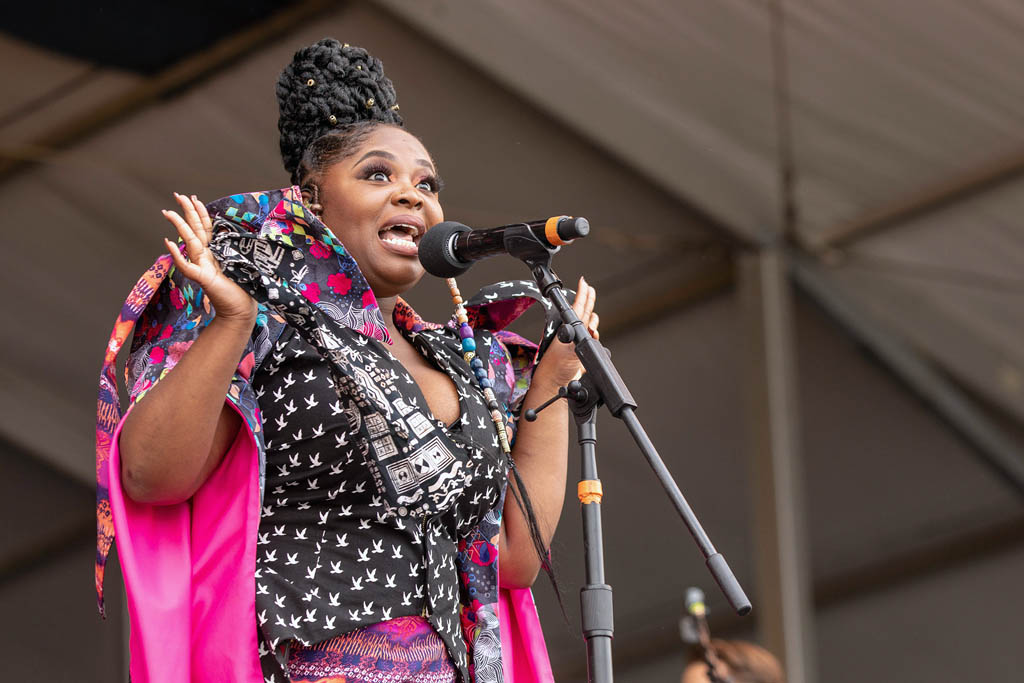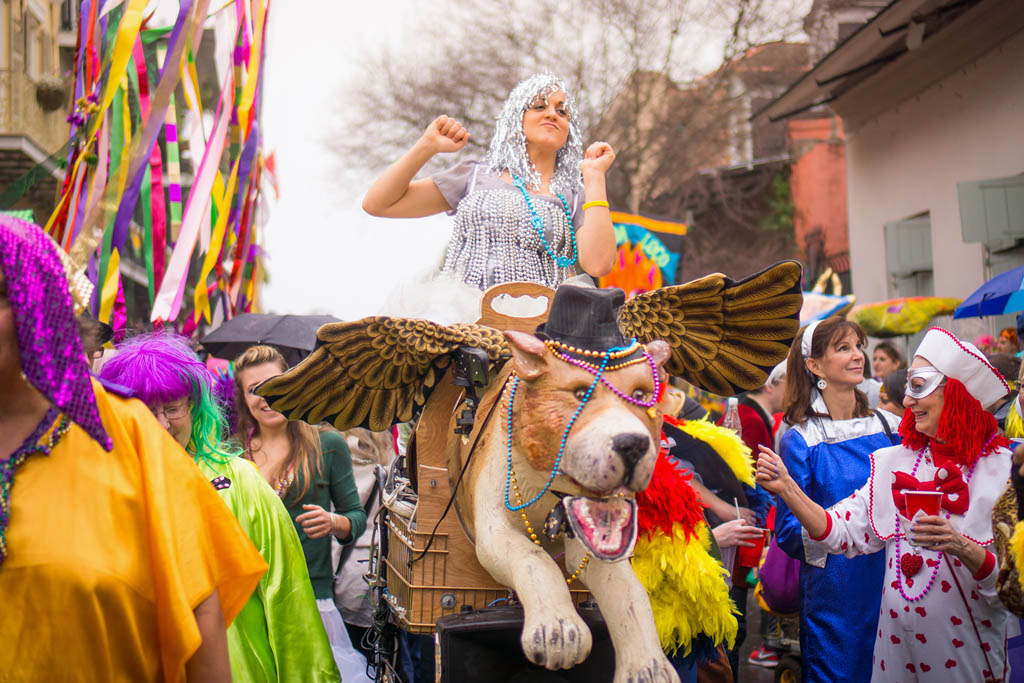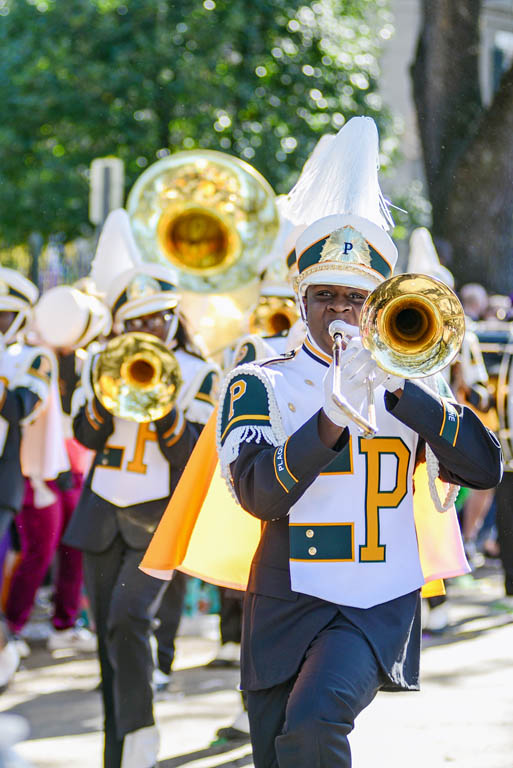Mardi Gras & Jazz Fest
Band of zombies? Check. Revelers riding giant neon shoes? Check. New Orleans’ flights of fancy and indulgence are realized like at no other time during these two events…
Festival Season in New Orleans
No two events encapsulate New Orleans like Mardi Gras and Jazz Fest. These festivals are more than celebrations: they contain within them every thread of the colorful, complicated New Orleans tapestry.
‘Stop exaggerating,’ you may say, to which we reply: ‘There’s no need to exaggerate.’ These festivals are incredible. Imagine a bunch of grown men and women riding giant neon shoes and plaster dinosaurs through the street; or Bruce Springsteen, Al Green, Dr John, Tom Petty, Cee-lo, Feist and the Carolina Chocolate Drops playing in the same venue in one weekend; or that you slip through the looking-glass into MOM’s Ball and see a band of zombies playing for naked folks in body paint and a cast of costumes that appear to be lifted from Jim Henson’s most lurid fantasies.
During Mardi Gras and Jazz Fest, all this happens. The city’s flights of fancy and indulgence are realized like at no other time. And everything that makes New Orleans…well…New Orleans becomes a lot more…New Orleansy. Let’s take the food. The best eats in the city turn up as booth fare in Jazz Fest. Restaurants throw open their doors during Mardi Gras to folks dressed as goblins and fairies. This all speaks to the creativity of the city, expressed in a multitude of ways, from music to visual arts, crafts and theater (as exemplified by Mardi Gras floats and costumes). These festivals reveal the soul of a city that is obsessed with beauty, while both redefining the concept and appreciating it in every way possible.
Finally, these festivals speak to the history of the city. Jazz Fest is such a celebration because New Orleans is the most important musical city in America, and artists from around the world come here to pay tribute to that fact. Mardi Gras has an older, more mysterious history, one that dates at least as far back as the early Catholic Church, and perhaps further into antiquity.
Between late January, when Carnival Season begins, and late April/early May, when Jazz Fest happens, it’s pretty much back-to-back celebrations in New Orleans, or as folks down here like to call it: ‘festival season.’ There are lulls here and there, but by the time mid-March rolls around it feels like there’s a small festival bridging these two big events every weekend.
So are we saying there’s basically a half-year of festivals in New Orleans?
Of course not. The party never stops in New Orleans. It just picks up between Mardi Grass and Jazz Fest.

Anatomy of a Celebration
The parade season is a 12-day period beginning two Fridays before Fat Tuesday. Early parades are charming, neighborly processions that whet your appetite for the later parades, which increase in size and grandeur until the spectacles of the ‘superkrewes’ emerge during the final weekend.

A Sensory Carnival
A popular preseason night procession, usually held three Saturdays before Fat Tuesday, is Krewe du Vieux. By parading before the official parade season and marching on foot, Krewe du Vieux is permitted to pass through the French Quarter. The themes of this notoriously bawdy and satirical krewe clearly aim to offend puritanical types.
Watch for Le Krewe d’Etat, whose name is a clever, satirical pun: d’Etat is ruled by a dictator rather than a king. Another favorite is Muses, an all-women’s krewe that parades down St Charles Ave with thousands of members and some imaginative, innovative floats; their throws (the goodies that the krewes throw to the crowd) include coveted hand-decorated shoes.
Mardi Gras weekend is lit up by the entrance of the superkrewes, who arrive with their monstrous floats and endless processions of celebrities, as flashy as a Vegas revue. On Saturday night the megakrewe Endymion stages its spectacular parade and Extravaganza, as it calls its ball in the Superdome. On Sunday night the Bacchus superkrewe wows an enraptured crowd along St Charles Ave with its celebrity monarch and a gorgeous fleet of crowd-pleasing floats.
On Mardi Gras morning, Zulu rolls along Jackson Ave, where folks set up barbecues on the sidewalk and krewe members distribute their prized hand-painted coconuts. The ‘King of Carnival,’ Rex, waits further Uptown; it’s a much more restrained affair, with the monarch himself looking like he’s been plucked from a deck of cards.

Costume Contests
Mardi Gras is a citywide costume party, and many locals take a dim view of visitors who crash the party without one. For truly fantastic outfits, march with the Society of St Ann on Mardi Gras morning. This collection of artists and misfits prides itself on its DIY outfits, which seem to have marched out of a collision between a David Bowie video and a ’60s acid trip. The creativity and pageantry on display really needs to be seen to be believed. Other parades that feature great homemade costumes include the Box of Wine parade, the Chewbacchus parade and the Red Beans & Rice procession.

Walking Krewe Review
Some of the best parades of Carnival Season are put on by DIY bohemian walking krewes, groups of friends who create a grassroots show. Casual observers are always welcome to participate. Just bring a costume!
Barkus Dress up your furry friends for this all-pet parade (www.barkus.org).
Box of Wine Crazily costumed revelers march up St Charles Ave ahead of the Bacchus (god of wine) parade, distributing free wine from boxes along the way.
Intergalactic Krewe of Chewbacchus Dress up as your favorite sci-fi character at this wonderful parade for geeks, nerds and other people we might hang out with on weekends (http://chewbacchus.org).
Red Beans & Rice On Lundi Gras (the day before Mardi Gras), folks dress up in costumes made from dry beans or as Louisiana food items.
Society of St Anne Traditionally made up of artists and bohemians, St Anne marches on Mardi Gras morning from the Bywater to the Mississippi and features the best costumes of Carnival Season.
OUR FAVORITE BIG PARADES
Krewe de Vieux Old-school walking parade with sharply satirical floats.
Muses All-female krewe with creative floats.
Zulu Traditionally African American krewe that throws coconuts to the crowd.
Rex Old-line royalty of Mardi Gras.
Thoth Family-friendly Uptown day parade.

New Orleans Jazz & Heritage Festival
Jazz Fest sums up everything that would be lost if the world were to lose New Orleans. Much more than Mardi Gras, with its secret balls and sparkly trinkets, Jazz Fest reflects the generosity of New Orleans, its unstoppable urge to share its most precious resource – its culture – with the rest of the world. Of course, the Fest is first and foremost about music, but it isn’t just about jazz. It’s jazz and heritage, which means any music that jazz came from, and any music that jazz inspired. The multitude of stages and tents feature everything that pours in and out of jazz – blues, gospel, Afro-Caribbean, folk, country, zydeco, Cajun, funky brass, and on and on.
INFORMATION
Gambit Weekly (www.bestofneworleans.com) publishes a Carnival edition during February or March, depending on the date of Mardi Gras. Mardi Gras New Orleans (www.mardigrasneworleans.com) is an excellent website for details of the festivities.
Roots of Roots Music
Jazz Fest began in 1970, when the idea of staging a big music festival in New Orleans couldn’t have been more natural. The first festival, held in Louis Armstrong Park, featured a remarkable lineup of legendary artists, including Duke Ellington, Mahalia Jackson, Clifton Chenier, Fats Domino and the Meters. Mardi Gras Indians performed, and every now and then a Second-Line parade swept through the audience. The ingredients were already in place for a major cultural event with a genuine regional significance. Outside talent, such as Ellington, complemented the local talent and beefed up the event’s exposure.
Only 350 people attended that first Jazz Fest. Most likely, the low numbers were due to poor promotion outside New Orleans. Out-of-towners arrived in much greater numbers for the ’71 Fest, and with them came a far stronger local response. To accommodate another anticipated jump in attendance, the Fest was moved to the far larger Fair Grounds Race Course a year later, and Jazz Fest really hasn’t looked back since. By the late 1970s, the festival had grown from one weekend to two, with many legendary moments already solidifying the event’s cultural importance.
Mesmerizing performances by the likes of James Booker, the Neville Brothers and Professor Longhair have been recorded for posterity. The musical lineup soon expanded to include big-time national acts, such as Lenny Kravitz, Bruce Springsteen and Bon Jovi, as well as international acts from South America, the Caribbean and Africa.

Experiencing Jazz Fest
Some people choose to do Jazz Fest over and over again, year after year, so obviously there’s something addictive about the experience. It doesn’t hurt that there are umpteen ways to approach this gargantuan feast of music, food and culture, which takes place over the last weekend of April and the first weekend of May.
Seeing the Stage
The first thing to decide is: one weekend of Jazz Fest or two? And if one’s enough, then which one?
No one will laugh if you choose one weekend. The drawback is you may have to pick your dates before the Fest schedule is announced. The schedule isn’t announced until early February at the earliest. Still, there’s statistical logic to making blindfolded decisions this way, as both weekends are always equally packed with big-name show-stoppers and unheard-of talents. Sometimes you’ll miss out on a personal favorite if you’re not attending every day of the Fest, but in the end something along the way will make up for the loss.
For those who make their Jazz Fest plans late – that’s to say, after February – there’s the advantage of knowing the schedule. Free-spenders are still likely to find a pricey suite of rooms in the French Quarter at this point, but thrifty types might be frustrated with finding accommodations. If you decide to do both weekends, you’ll have four days for bopping around town, or maybe driving out to Cajun Country for Festival International de Louisiane (www.festivalinternational.com) in Lafayette. ‘Festival’ is the largest free francophone music festival in North America, and is held during the last weekend of April.
It’s worth noting that the area of Esplande Ave just outside of the Fair Grounds becomes as festive as Jazz Fest itself. Folks crowd around spots like Liuzza’s and a general street party takes over the streets parallel to the Fair Grounds for about two weeks. In the days in between actual Jazz Fest weekends, many fest performers put on shows at venues around town – sometimes unexpectedly, and for free!

At the Fair Grounds
It takes a well-bred racehorse about two minutes to circumnavigate the Fair Grounds track, but the average human will require up to 10 minutes to get from one stage to the next. The only way to get from stage to stage is to walk or half-jog through dense crowds and all kinds of tempting food stalls and vendors. Be on the lookout for the Louisiana Folklife Village, which has plenty of demonstrations of Louisiana folk crafts. Jazz Fest consists of over a dozen performance tents:
Gospel Tent A cherished chapel of earth-shaking live gospel music.
Jazz Tent The lineup here leans more toward the contemporary side of the jazz genre.
Jazz & Heritage Stage Smaller stage where brass bands and the Mardi Gras Indians perform.
Economy Hall Tent Stomp your feet to New Orleans trad jazz with the likes of the Preservation Hall Jazz Band and the Tremé Brass Band.
Lagniappe Stage Varied entertainment. The stage’s isolation from the rest of the Fair Grounds makes it ideal for intimate performances.
Blues Tent Blues, R&B, funk and, occasionally, some rock.
Fais-Do-Do Stage Cajun and zydeco music is the emphasis at this always-hopping stage.
Congo Square This stage has become the venue for world acts from Africa and Latin America.
Acura Stage Main stage where the biggest names appear.
Gentilly Stage Secondary main stage.
Kids Tent Children’s music and family-friendly activities.
Allison Miner Music Heritage Stage Mainly hosts lectures and panel discussions with Jazz Fest artists.
Food Demonstration Stages Local live cooking lessons at these two stages.

Food, Glorious Food
In addition to the obvious musical draw, Jazz Fest is justifiably famous for its food stalls, many of which have cult followings. Some of the more popular Fest foods include fried soft-shell crab, Crawfish Monica (cream crawfish sauce over fusilli pasta), crawfish bread, cochon de lait (roast suckling pig), po’boys, spinach and artichoke casserole, Cuban sandwiches and Jamaican chicken. Of course, you’ll also find jambalaya, red beans and fried catfish.